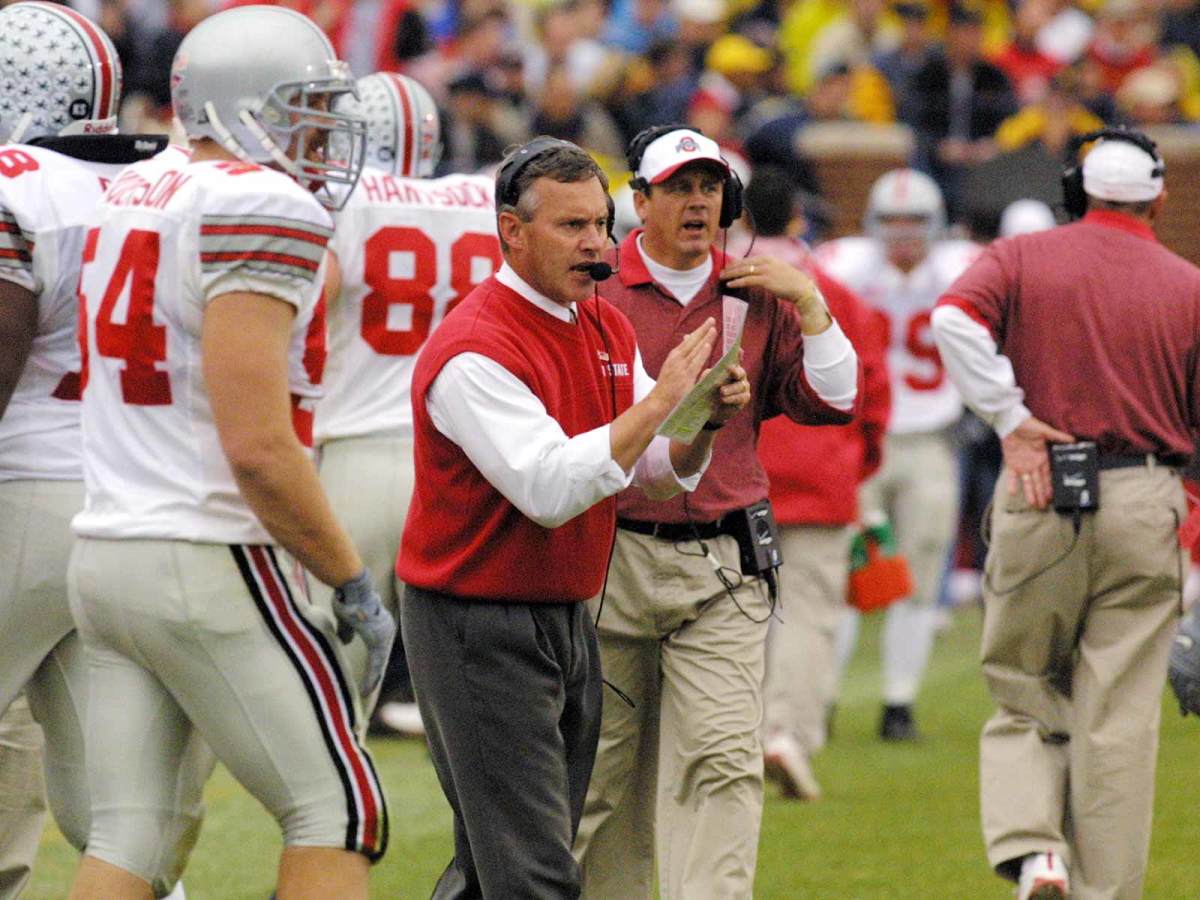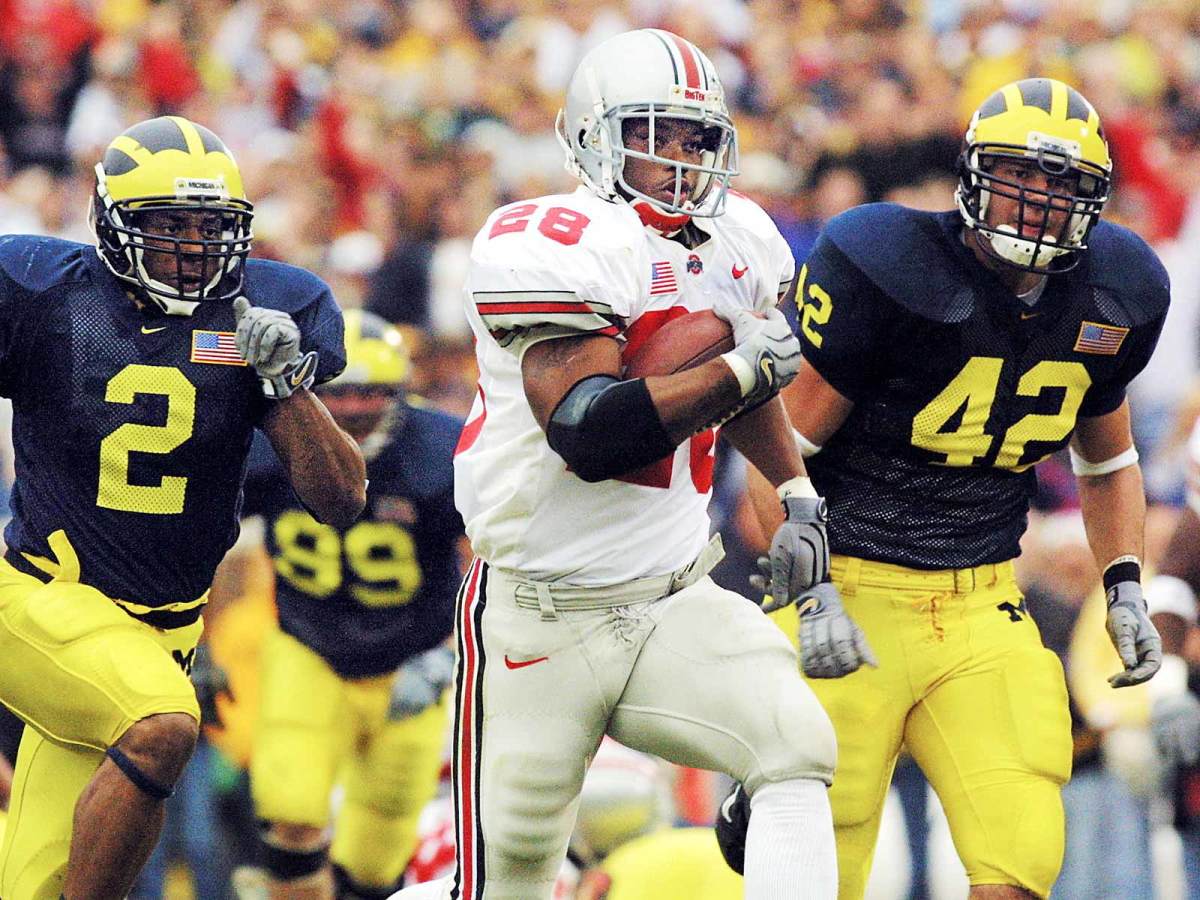Jim Tressel Looks Back on the Unintentional Guarantee That Flipped Michigan–Ohio State

Jim Tressel wasn’t expecting to say anything. On the night he was formally introduced as Ohio State’s new head coach, greeting the crowd at the Ohio State-Michigan basketball game in Columbus on Jan. 18, 2001, he thought he’d smile, wave and “we’d live happily ever after,” as Tressel says now. But that evening, following introductory remarks by former athletic director Andy Geiger, Tressel was abruptly handed a microphone.
On the spot, he came up with his first address to Buckeye Nation: “I can assure you that you will be proud of your young people in the classroom, in the community, and most especially in 310 days in Ann Arbor, Michigan.”
No one realized it at the time, not even Tressel, but that moment in January changed the Michigan–Ohio State rivalry. His words served as the beginning of a psychological shift, from Michigan domination to Ohio State domination. His predecessor John Cooper posted a 111-43-4 record by the time his tenure ended in 2000, but he couldn’t beat Michigan, going 2-10-1. If the series had been split over that last decade, Tressel wouldn’t have had to reference Michigan or know the exact number of days remaining until kickoff. But he knew something had to change. And since Tressel’s speech, Ohio State is 15–2 against its most hated rival, including 8–1 in his tenure.
“I’m sure if I had said, ‘In 272 days we play whomever,’ that might not have gotten that type of response,” Tressel says, reflecting on the roaring applause from 18,000 fans. “But it was their feedback that they, too, thought it was important.”
There was some skepticism about Tressel upon arrival. Cooper had won the Rose Bowl following the 1996 season; Tressel had won Division I-AA national championships at Youngstown State (where he now serves as university president). But Tressel quickly demonstrated that he was a fit by being intimately aware of the importance of flipping Ohio State’s place in the Michigan rivalry.
“He’s really good on his feet,” says Ellen Tressel, Jim’s wife. “He’s really good unscripted. I don’t know that he’s ever written a speech in his life. He’s that talented when it comes to sizing up the crowd and understanding what he needs to say.”
His words had a resounding effect in Michigan that night, too. Ron Bellamy, who played wide receiver for the Wolverines from 1999 to 2002, remembers when the team heard of what’s now become better known as Tressel’s “guarantee”—even though Tressel says that’s not what it was.
“Coach Tressel came in there and changed the mentality of that team,” Bellamy says. “We were in our apartments when we [got word] of his speech. We didn’t like it. It was one of those things where, rest assured we were prepared. Our season was dedicated to making sure Tressel didn’t fulfill that promise he made to Buckeye Nation.”
AXSON: Ranking the Rivalry Games With the Most on the Line in Week 13
Tressel always knew the number of days until the Michigan game. He had it documented in his morning journal, and the local media often tested his memory to see if he was staying on top of the countdown from 310. When he said it off the cuff in January, it had already been ingrained in his mind from the interview process.
“There were a few times [reporters] would ask me and if we hadn’t talked about it that much, you kind of had that hesitation like, ‘Oooh, I think it’s 171 days,’ or whatever it was,” Tressel says.
Tressel also put up three clocks in the Woody Hayes Athletic Center—in the locker room, in the weight room and in a main hallway—that all ticked down to kickoff of the Michigan game, so his players and coaching staff also knew how many days were left.
Too many times before Tressel’s arrival, Ohio State had near-perfect years upended by losses to Michigan in the season finale. There was 1993, when the Buckeyes hadn’t lost a game and were heading to the Rose Bowl before a 28–0 loss to Michigan sent them to the Holiday Bowl instead. At that point, Cooper had failed to beat the Wolverines in his six years as head coach. In the postgame news conference, Cooper said, “It’s frustrating not to be able to beat them.” As he walked out the door, a reporter called after him and asked just how frustrating it was. “About as frustrating as it could be,” Cooper said. There was 1995, when Ohio State was undefeated and ranked No. 2 until a loss to Michigan redirected them to the Citrus Bowl. Before that game, receiver Terry Glenn claimed, “Michigan’s nothing,” which naturally motivated the Wolverines to pull off a 31–23 upset. There was 1996, when Michigan beat the previously undefeated Ohio State team that would win the Rose Bowl; 1997, when the Wolverines edged the No. 4 Buckeyes en route to a share of the national title; and so on.
Tressel doesn’t believe there was a mental block when it came to The Game, just that the team needed a deeper understanding of how to win big games. Three-time first-team All-America safety Mike Doss remembers that throughout Tressel’s tenure, part of practice every week of the season would be dedicated to Michigan, regardless of that Saturday's opponent. While it might have just been 10 minutes of punt blocks, kickoff returns, tip drills or scooping and scoring instruction, the coaching staff called it the “Team Up North” period to keep Michigan on everyone’s mind.
Every Saturday morning during spring practice, Ohio State watched one quarter from a previous Michigan game as a team. Tressel walked his players through key moments: plays they lost, plays they won, and then showed three or four more moments that further highlighted his points. Doss remembers watching the tape from his freshman year, the 1999 loss to Tom Brady and the Wolverines in which the Buckeyes led 17–10 late before a few mistakes ultimately cost them. In the final minutes, Ohio State picked off Brady and ran it back to the Michigan 30, but a holding penalty nullified the play. Two plays later, Doss forced a fumble, but OSU couldn’t score on third-and-goal from the six-yard line and missed a field goal. Michigan went on to win 24–17. Tressel would do this every spring throughout his tenure, whether Ohio State won or lost.
“We were just like, ‘Oh my God,’” says Doss, recalling those comprehensive review sessions. “We put time into Michigan and getting into that mindset. It was like he was teaching us the philosophy of this game and what it meant.”

Ohio State entered Tressel’s first Michigan game with a 6–4 record, and Tressel was preparing redshirt sophomore backup quarterback Craig Krenzel to face the Wolverines after starter Steve Bellisari had been suspended for drunken driving the night before the previous week’s loss to Illinois.
In the midst of a hectic week, Tressel remembers receiving a letter from Fred Martinelli, who had coached at Ashland University (85 miles northeast of Ohio State) for more than three decades and would soon be inducted to the College Football Hall of Fame. His message was that this game would come down to fourth-and-one: Ohio State would either make it or stop Michigan in that situation, but that would be the difference.
“I thought, well that’s interesting,” Tressel says. He shared the letter with the team that week and went on with his preparation.
Ohio State led Michigan 7–0 at the start of the second quarter when Krenzel completed a 12-yard pass to Chris Gamble on third-and-13. Tressel remembers Gamble trying to stretch for as many yards as he could, but he was one yard short.
“We were fourth-and-one,” Tressel says. “And I remember guys turn to me and say, ‘Hey, you said the difference was going to be fourth-and-one, let’s go for it.’ And I thought, ‘Oh my gosh, here’s this conservative guy from a small college who would normally punt on fourth-and-one from the 50-yard line or whatever.’ And I thought, ‘Well, I did tell them that, and I can’t be telling them things I won’t back up.’ So I said let’s go for it.”
Jonathan Wells took a handoff to the right side, cut upfield and ran 46 yards untouched for a touchdown.
Ohio State led 23–0 in the third quarter before Michigan made a comeback, but the initial deficit and Wolverines quarterback John Navarre’s four interceptions proved to be too big of a hole to climb out of and the Buckeyes won 26–20. It was Ohio State’s first win over Michigan in seven years, and its first win in Ann Arbor in 14 years.
“I felt so good for our seniors, because they hadn’t beaten them, and I felt so good for our fans and the people in the state of Ohio because I knew how important that was to them,” Tressel says. “I could feel their joy.”
The home and visiting locker rooms are directly across the hall from each other at Michigan Stadium. Before kickoff, Doss remembers Wolverine players screaming and bouncing around while the Buckeyes quietly watched. He describes the silent Michigan locker room after the game as “the best feeling ever.”
“When the game was over, it was one of those ah-ha! moments, like, we did it,” says Doss, who snagged two interceptions. “Tress did it. He promoted it, we believed, we had the countdown clock, the extra periods in practice, the film during spring ball. It all culminated to that moment when the clock struck 00:00 and we beat them on their field for the first time since 1987. We knew then the tide had turned.”
That game—as well as the ensuing close Outback Bowl loss to South Carolina—set Ohio State up for the following season, when it went undefeated and won the 2002 BCS national championship. Doss says if the Buckeyes had lost to Michigan in ’01, he would have left school early and turned pro. Instead, he came back to play with his senior class and was named title game MVP a year later.
“I think every one of those experiences helped us toward the next year,” Tressel says. “I think there’s no question it gave us confidence that we could compete.”

The Buckeyes won The Game in six of Tressel’s first seven years against Lloyd Carr, but Ohio State and Michigan were evenly matched each time, and the outcome could have gone either way. After Carr retired in 2007, the Buckeyes gained a significant edge as the Wolverines struggled under Rich Rodriguez and then Brady Hoke. Tressel resigned in 2011 as the program braced for NCAA violations he knew had taken place, but Ohio State has continued its run of rivalry dominance under Urban Meyer.
Now, Jim Harbaugh has Michigan rolling. Both teams are 10–1 heading into Satuday with a spot in the Big Ten title game—and maybe the College Football Playoff—on the line. Harbaugh is 0–3 against Ohio State but finally has the better team and the better defense. Meyer’s team was upset by Purdue, nearly lost to Maryland, and has been mired in off-field drama all season. The past two months suggest the Wolverines deserve to be favored, but for nearly two decades the Buckeyes have held a firm edge. And it started with Tressel.
“The only way we ever measured any other game or any other moment versus the Michigan game is we always used to talk about that one yard in the Michigan game is worth two. Everything is magnified times two,” Tressel says.
“I guess surmising the discussions we constantly had, I suppose you could say it was twice as important as anything else.”
